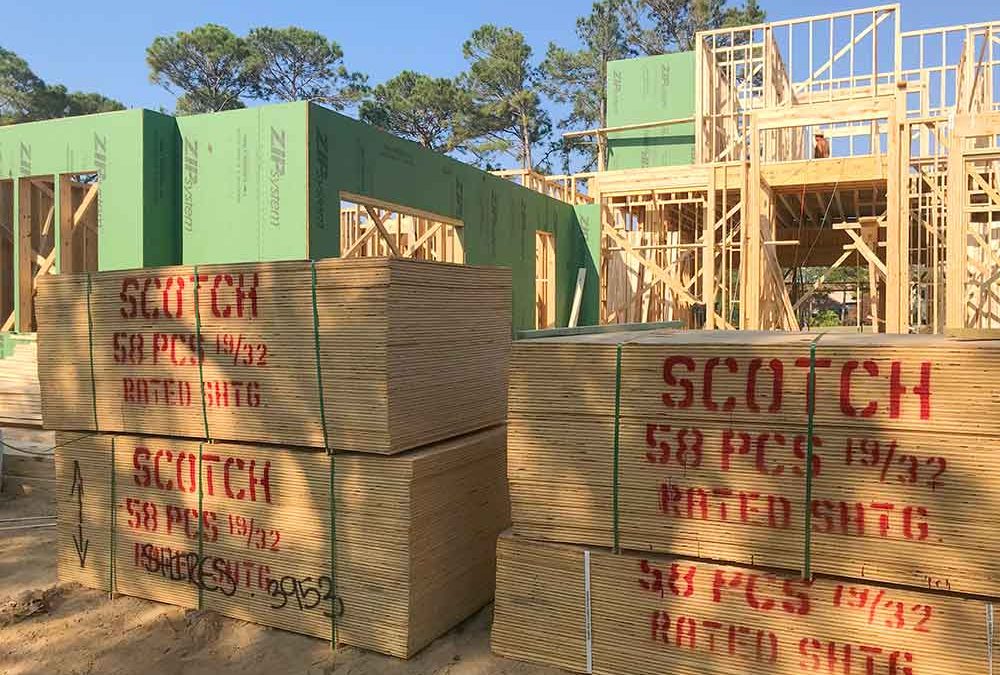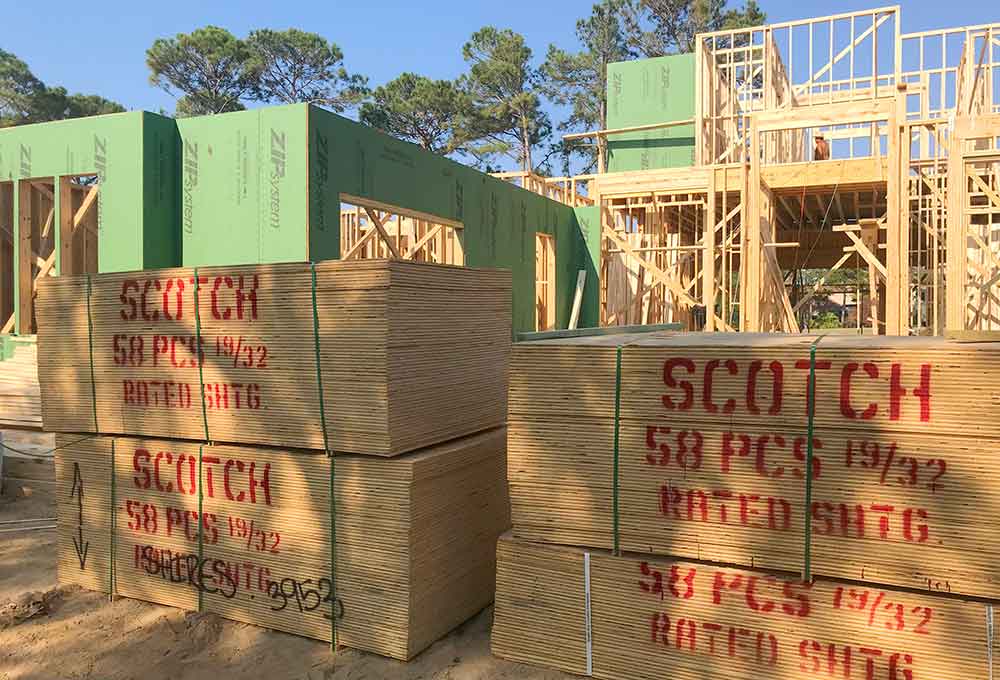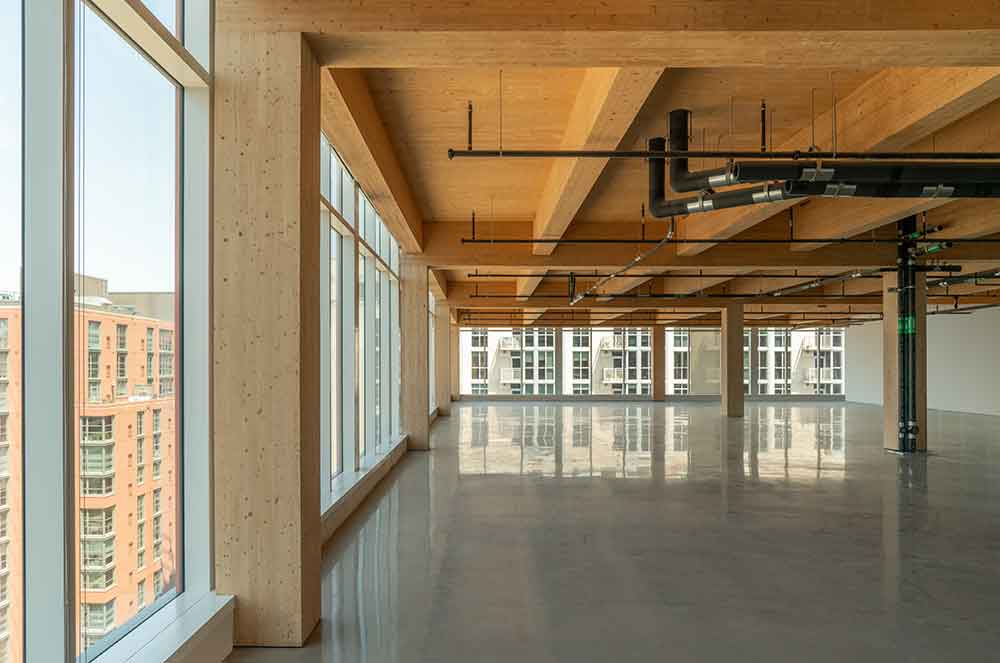Doug Pauze, president of Coastland Wood Industries, Nanaimo, BC, provided his insights on Coastland’s Meinan “hybrid” installation, including lathe and charger. He showed photos of the machinery installation and its successful integration into the downstream process.
Rob Freres, president of Freres Engineered Wood, Lyons, Ore., discussed his company’s new Meinan 8 ft. green veneer composer installed in December 2021, which joins green or dry veneer.
He cited advantages such as preventing overlap defects in the core veneer, special heat activated paper tape providing a strong joint and staying on during the drying process. He noted minimal dryer shrinkage and no telegraphic transfer of tape to the face veneer.
Kevin Nesbit, national sales manager with Player Design, Inc. (PDI), spoke on innovative low ash biomass energy systems for wood products plants, and in particular about PDI’s burner technology.
He pointed to numerous features such as vertical combustion, center fed fixed grate slope circular burner (3200°F refractory bricks), screw augur feed, multi-stage combustion with customized air control, automatic ash removal, green or dry fuel, abort systems.
Nesbit reviewed several installed operations such as a new 45MM BTU green fuel combustion system at a 100% hardwood (shavings, sawdust chips) operation where the capacity of the dryer increased by 35% and emissions were reduced by 28%; and at a 100% southern yellow pine materials operation where
PDI technology replaced three dryers and dust furnace and has seen a 20% increase in plant productivity, running a new green fuel combustion system, 35MM BTU/hr and running 30,000 OD PPH. PDI technology enhancements have delivered stability in furnace and efficiency of combustion, lower CO emissions by more than 50%, less sparking and better drying control; as well as fuel flexibility, including utilization up to 60% MC. Each dryer or kiln can be supplied by an individual burner, allowing for continued plant operation of other dryers during maintenance or downtime.
Tom Wechsler, president of Wechsler Technologies & Engineering, spoke on his company’s new CenterFire wood fuel suspension burner.
Wechsler addressed the pros and cons of scroll and cyclonic suspension burners and why his company has developed a new burner, mainly because of existing older technologies, high frequency of shutdowns and limited combustion and temperature control.
The CenterFire is a compact design so it can fit in the space of most existing burners for easy replacement. Wechsler said other features included a centrally injected fuel stream to avoid contact with wall; various air zones to control temperature profile; multiple tangential air injection for effective film cooling of wall to prevent slagging; duel fuel flexibility if desired; minimal spark carryover; low emissions; advanced, multipoint temperature control; fully automatic PLC based control.
He said the potential annual cost savings of the CenterFire over conventional fines burners can top $830,000, especially due to less downtime and consequently less production loss; and also in refractory/relining savings and cleanout labor savings.
Raskesh Govind, president of PRD Tech, spoke on microemulsion assisted biotreatment of VOCs in exhaust gases. He pointed to traditional treatment technologies that consume substantial amounts of natural gas, which is increasing cost, and producing tons of carbon dioxide.
Microemulsion is a dispersion of a hydrophobic phase within water and this dispersion is stabilized by a surfactant/ co-surfactant; the hydrophobic phase has a high affinity for water insoluble VOCS, while the water phase has a high solubility for water soluble compounds, such as methanol.
Microemulsions result in lowering the Henry’s Law constant for water-insoluble VOCS, thereby lowering the liquid flow rates in the absorber, Govind said, adding that microemulsion abosorbers combined with bioreactors can biodegrade a wide variety of VOCS—water soluble and insoluble.
“The investment and operating costs for micoemulsion absorbers with bioreactors are substantially lower than” traditional methods, Govind concluded.
Grigorii Bunimovich, director at Matros Technologies, addressed RCOs, and in particular catalyst monitoring and maintenance. He pointed out that using catalysts in post-dryer RTOs provides substantial energy savings that well-justify the initial costs.
He said annual testing of worked catalyst samples generates recommendations on catalyst maintenance involving periodic regeneration via bakeout and gradual increase in RCO temperature.
He emphasized a new tubular reactor as part of catalyst activity testing that enables testing actual VOCs of interest with any type of commercial catalyst. The experimental destruction efficiency is close to one achieved in the RCO. He also pointed to the use of a stirred reactor for quick express testing with model VOCs.
Bunimovich said catalyst sample held for a year in the RTO operating after the wood dryer and WESP retains appreciable performance; and that for enabling catalyst application, the WESP should provide good PM removal and exclude liquid carryover.
More specifically he emphasized the efficiencies of base-metal catalyst that has demonstrated high efficiency for removal of methanol, formaldehyde and other HAPs and VOCs along with exceptional thermal resistance and high durability.
Steffen Bots, technical sales expert for Addinol Lube Oil, addressed the impact of friction on energy consumption. Looking at the big picture, Bots said 23% (119 EJ) of the world’s total energy consumption originates from tribological contacts (interacting surfaces in relative motion); 20% is used to overcome friction and 3% is used to remanufacture worn parts and spare equipment. By taking advantage of the new surface, materials, and lubrication technologies, energy losses due to friction and wear could be reduced by 40% in the long term (15 years) and 18% in the short term (eight years). “On global scale, these savings would amount to 1.4% of the GDP annually and 8.7% of the total energy consumption in the long term,” he said.
He specifically addressed challenges for lubricants in the wood panel industry, including operating conditions, production technology, variety of wood composition, and focused more on continuous presses, desiring minimized friction based on thicker lubrication film and friction modifier, and stronger wear protection by higher film thickness.
He pointed to a case study of a successful operation of continuous presses in Germany using Addinol Belt Lube HT, citing 30% less oil consumption due to optimal lubrication and 50% reduction of power consumption due to lower friction coefficient. He talked about Addinol lubricants (Eco Gear) for gearboxes, hydraulics, bearings and roller drums.
“Tribology is an underestimated discipline but is an important piece of the puzzle to more efficiency,” Bots said. “Lubricants are not the problem, they are part of the solution.”
Thomas Brotski, principal at Harrison Group, and Matt Cowen, sales manager with KCF Technologies, spoke on optimizing forest products mills and how industry leaders are reducing downtime, increasing throughput and driving industry 4.0 strategies.
They pointed to three challenges facing the industry that are driving the adoption of new technologies, including demand increase, cost reduction and talent shortage. They discussed value drivers such as optimization of maintenance through PM quality checks and prioritization, and optimization of machines through definition of optimal SOPs. They discussed the “right” technologies and process (wireless protocol/ shop floor machine learning/industrial grade hardware, etc.) from a dangerous and safe perspective. And concluded with the importance of personnel on the shop floor as part of the procedure from machine data to optimal plant operation.
Timothy Young, CEO and president of T.M. Young Institute and data scientist professor, spoke on the concept and use of Digital Twins as a key step in implementing machine learning and AL.
One key technology in ensuring success in implementing Industry 4.0 is supervised machine learning, Young said, enabling analyses of massive quantities of data. Digital twins mimic processes and human interactions by using simulations of the machine learning predictions— basically a virtual replica. For example, a control room operator relies on PLC logic from sensor data and human intuition from experience to optimize throughput while maintaining product conformance. A digital twin from machine learning algorithms mimics the decisions of control room operators for validation and may provide enlightenment for improved process optimization.
Young said “variable importance” is a key to digital twin development; that variation is cumulate, influences process targets, and is directly related to economic loss.
Wendy Owens, CEO of Hexas Biomass, discussed non-wood “green” boards and building materials. She defined “green” as better than netzero/ do-no-harm life cycle; locally sourced; protects and improves local ecosystems; and supports local communities. She said there is growing consumer demand for non-wood in combination with government promotion of “green” building materials.
She addressed the uses and advantages of several non-wood materials including coconut husk fiber, bamboo, hemp, and finally her company’s product, Xanograss, citing several benefits: low water use, climate resilience, no pesticides needed, no food crop displacement, EPA-approved, 15-year high yield from a single planting.
Further, she talked about hybrid or 100% Xanofiber particleboard and MDF meeting various standards in bonding, flexural property and water absorption, and as OSB with high resistance to mold and improved profile.
“Hexas’ goal is to make the highest and best use of all biomass,” Owens said. “We are developing IP, systems, and even a marketplace to do just that.”
Stefan Zöllig, principal at Timbatec Engineering, spoke about the dawning of a new day for an old product that has never come of age, at least not yet—Scrimber, as a carbon sequestering raw material for mass timber products.
He cited the well known climate and carbon advantages of wood over materials such as concrete, brick and steel. “How to do you produce building material out of CO2?” he asked, then answered, “Our forests do produce materials out of CO2,” which is one of the environmental attributes for the rising demand of timber buildings—public, residential and commercial. And he pointed to the ample yearly forest growth worldwide, of which sawnwood consumes only 10%.
Zöllig reviewed the production of Scrimber (now patented as the TimTek process) that originated with the Australia industrial research organization (CSIRO) in the 1970s, which entails basically crushing the log piece (scrimming) into interconnected strands, drying, resin application, drying, layup, pressing and cutto- finish as long fiber billets.
Zöllig pointed to CLT and glulam as potential markets and reviewed recent research efforts, feasibility studies and promised investor finances, and offered a roadmap to a pilot plant and a standard plant by the end of the decade.
Patrick Donahue, building products research program manager at Natural Resources Research Institute, addressed the charter mission of NRRI—to foster economic development of Minnesota’s natural resources in an environmentally sound manner and promote private sector employment. NRRI has significant research and lab locations at Duluth and Coleraine, Minn.
He spoke about the National Science Foundation’s Innovation Corps (I-Corps) seven-week hands-on course geared to the understanding and potential value of technology and assessing the market opportunity for new technology. The course environment is fast-paced; teams are pushed and challenged.
In 2021 Donahue was awarded an ICorps grant and his course team focused on the development of a business for a multi-functional building envelope panel solution. The team interviewed more than 140 stakeholders across all aspects of the building construction value chain.
He said several lessons were learned: the construction industry is extremely fragmented; some customer segments are not willing to pay more for environmentally sustainable building materials; if innovations are going to succeed, a comprehensive communication strategy is key.
Especially timely was Richard Poindexter’s talk on wood products employment trends and how to keep employees engaged. Poindexter is president of Search North America. He immediately caught everybody’s attention with a real world example of wood products companies having to compete with fast food restaurants that are paying workers $16-$18 an hour.
However, job opportunities abound in the wood products industry, from executive to entry level, due to COVID, the retirement of Baby Boomers, organizational realignment and simply people looking for new opportunities and having the leverage to do so. He said workers today want to earn a good salary, develop their skills, have flexible hours and feel appreciated.
How do you keep workers engaged? Poindexter pointed to cross training, employee survey feedback, educational reimbursement, bonuses, recreational perks and constant emphasis on their safety.
“Based on employment and demographic data this pattern of more jobs than people to fill them may last for a while,” Poindexter said.



